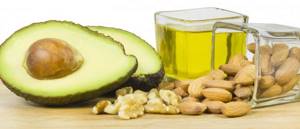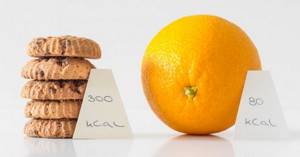Calorie counting: formulas
Harris-Benedict formula
The formula is based on information about your height and weight, as well as the activity of your daily life. When calculating activity, the following coefficients should be used:
- if you lead a sedentary lifestyle and do not play sports, then your coefficient is 1.2;
- if you do sports 3 times a week – 1.375;
- playing sports 5 times a week – 1.46;
- your work involves physical activity, and in addition to this, you also play sports intensively – 1.55;
- if you play sports every day, then your coefficient is 1.64;
- you can do intensive sports several times a day – 1.73;
- you work in hard physical work and, on top of that, exercise vigorously several times a day - then the coefficient is 1.9.
The formula itself looks like this:
(88.36 + 13.4 * weight in kilograms + 4.8 * height in centimeters – 5.7 * age) * physical activity coefficient.
Let’s take, for example, a 28-year-old girl, height 170, weight 55 kilograms, who goes to the gym 3 times a week. It turns out that according to the Harris-Benedict formula, the daily calorie intake will be: (88.36+13.4*55+4.8*170-5.7*28)*1.375=2037 kilocalories.
The formula was developed back in 1919, and is still relevant today.
Miffilin-San Geor formula
A relatively new method of calorie counting. The formula looks like this:
(10 * weight in kg + 6.25 * height in cm – 5 * age + 5) * physical activity coefficient.
Using the same girl as an example, we get the following data: (10*55+6.25*170-5*28+5)*1.375=2031 kilocalories per day.
We see that calculations using both formulas give approximately the same values, so it does not make much difference which formula you choose.
Katch-McArdle formula
Thanks to the use of precise readings, this formula is considered the most highly accurate currently used. The downside is that you will need to know the exact percentage of body fat in your body. This percentage is defined as the ratio of body fat mass to body weight. Currently, there is no method that will uniquely and accurately determine the percentage of fat in your body; they all have errors.
How to properly reduce daily calorie intake to lose weight?
For harmonious and safe weight loss, it is recommended to reduce the caloric content of the diet, taking into account physical activity, by 10-15% (by 20% for severe obesity). The daily calorie content should not be lower than the following indicator:
Weight in kg/0.45 x 8
WHO recommends reducing food intake by 500 kcal per month from the actual diet until the calorie content is 300-500 kcal below the daily requirement.
Reducing the daily intake by 500 kcal per day leads to a loss of approximately 500 grams of fat mass per week. After six months of such weight loss or upon reaching your ideal weight, it is recommended to recalculate the daily calorie intake taking into account new indicators.
You shouldn’t cut your calorie intake as much as possible to lose weight more effectively. A loss of 250-500 grams per week is considered physiological and safe for health. Exceeding these numbers means loss of muscle and fluid.
Why do you need to count calories?
Give preference to healthy products
We need food every day. It depends only on ourselves how much benefit nutrition will bring us. Working, performing routine household chores, and playing sports, we spend energy. Energy enters our body with food, and it is important to correctly calculate its quantity and quality. Food, like fuel, in the process of digestion releases the energy that our body needs.
Playing sports and other physical activities can only be beneficial if you eat properly. Without this, you can achieve results for a long time, but still not achieve what you need.
Depending on the goals we pursue, we can distinguish:
- counting calories for weight loss;
- counting calories for weight gain;
- counting calories to maintain weight.
It is clear that losing weight will require fewer calories than gaining weight. In addition to counting calories, we must not forget about balancing the main building blocks of energy - proteins, fats and carbohydrates.
Hand in hand with counting calories goes the development of a proper, balanced diet. Food must contain the required amount of the right carbohydrates, proteins, fats, vitamins and minerals. Only under this condition will nutrition be truly useful, providing all the needs of the body and charging us with the necessary correct energy.
Why count calories?
The cells of our body are constantly engaged in the absorption, processing and utilization of nutrients supplied to them. Ideally, the balance between these processes should not be disturbed, but in reality there is often a bias in one direction.
For example, a person goes on a diet and at first his body weight decreases. But then the scales stop, despite the fact that nutrition is as limited as possible. This phenomenon is explained by the fact that under stressful conditions the energy saving mechanism is activated. Metabolism slows down, and tissues begin to actively store nutrients.
If the number of calories consumed is greater than energy expenditure, a person gains weight. With an increase in physical activity without appropriate adjustments to the diet, the volume of body fat inevitably decreases. Properly selected nutrition will allow you to quickly adjust your figure without experiencing hunger or fatigue.
When planning to lose weight, build muscle, or maintain your weight, you need to accurately calculate your daily calorie intake and the ratio of proteins, fats, and carbohydrates.
Chemical composition of food
The food we consume consists of proteins, fats and carbohydrates. Let's look at what each of these “building blocks” is for and what role it plays in generating the energy we need and building our body.
Squirrels
Protein is the unshakable foundation of our body; all our cells are made of it. Protein is made up of amino acids. Once in the digestive system, protein is broken down into amino acids, which are the building materials for the cells of our body.
There are 20 different amino acids in total. 9 of them are “urban planners” and must be ingested with food. All beneficial amino acids are found in meat, but this does not mean that they cannot be obtained from plant foods.

Protein-rich foods
Protein is very important for children; there simply cannot be a deficiency of it in the diet. For adults, protein does not lose its value. It is widely believed that a person should consume 1 to 2 grams of protein per kilogram of weight per day.
Proteins are “carriers” of substances throughout our body. Hormones and enzymes are also proteins responsible for the normal functioning of our body. The most important property of protein in our body is that it is involved in the replication of DNA and RNA cells. The intake of protein into the body is facilitated by the consumption of the following foods: chicken breast, eggs, red fish.
It is necessary to select products in such a way that, in addition to protein, they deliver other useful substances to the body. Cottage cheese is a rich source of calcium, red fish contains omega-3 fatty acids necessary for heart function. Legumes are a source of vitamin B.
Considering the above, it becomes clear that the role of proteins in our body can hardly be overestimated. You can get proteins from a wide variety of foods - milk and dairy products, meat, mushrooms, fish and seafood, and legumes.
Fats

Sources of Saturated Fat
Fats (lipids) are the main source of energy in our body. In addition to energy, fats have an important protective function - the membrane of cells and internal organs consists of 30% adipose tissue.
It is a common misconception that fats are a harmful part of our diet. This is wrong. The lack of fat significantly reduces performance and energy production in the body. The only harm of fats is that when they are consumed in excess, lipid molecules unused for the construction of cells are deposited in the body. It is important to maintain enough fats and not to overdo it with their consumption.
Fats are divided into saturated and unsaturated . They differ in their composition - saturated fats have much more built-in hydrogen molecules in their structure than unsaturated fats. Unsaturated fats are not stored in the body. When consumed in excess, saturated fats accumulate and create fat deposits.
Saturated fats include substances found in animal and poultry fat, butter, and eggs. Their number needs to be reduced. Unsaturated fats are found in green vegetables, herbs, seafood, flaxseed oil and soybean oil.
An amazing property of unsaturated fats is that they help burn excess fat in the body during physical activity. To achieve success in sports, be sure to include foods that include unsaturated fats in your diet.
Carbohydrates

Reduce the amount of baked goods
More than half of the energy that is necessary for the normal functioning of our body is formed during the processing of carbohydrates. The brain receives its main nutrition from their breakdown.
Carbohydrates are divided into simple - monosaccharides and disaccharides, and complex - polysaccharides. Simple carbohydrates include glucose and fructose, while complex carbohydrates include fiber, starch and pectin. Experts recommend consuming carbohydrates separately from other foods, as they are quickly processed, unlike fats and proteins. The breakdown of carbohydrates begins already in the esophagus.
Complex carbohydrates contain a very important component for our body - phytonutrients . They promote weight loss, speed up metabolism and slow down the aging process. Rich sources of carbohydrates are confectionery, bread, beets, cherries, and apples.
When consuming carbohydrates, simple and complex, you should pay attention to their glycemic index.
Basic Concepts
There are many online calculators and proprietary formulas to calculate daily caloric intake. Sometimes they are difficult to understand because of the terminology. A small dictionary on this topic will help you master the basics of this aspect of dietetics.
Energy Value
Translation: energy value.
Definition: nutritional value of food products, determined by their BJU content. Indicated in calorie tables.
BMR
Explanation: Basal Metabolic Rate.
Translation: basal metabolic rate (metabolism).
Definition: the optimal amount of calories that allows the body to function at rest.
NEAT
Explanation: Non-exercise Associated Thermogenesis.
Translation: thermal expenditure not related to training.
Definition: The number of calories added to BMR that are expended through daily physical activity. Energy that is spent in the process of cleaning the house, talking, walking, working, shopping, etc.
EAT
Transcript: Exercise Associated Thermogenesis.
Translation: exercise-related thermal expenditure.
Definition: The number of calories added to BMR that are expended through athletic training. This indicator depends on the intensity of the activity. It’s one thing when a person spends 2 hours in the gym three times a week, and it’s completely different if he occasionally stands on the elliptical for 15 minutes.

TEF
Transcript: Thermogenic Effect of Feeding.
Translation: thermogenic effect of food.
Definition: consists of the calorie content of food that a person consumes per day. The number of meals does not matter for this parameter. The main thing is the quality and volume of products consumed. There is a difference between someone who includes mostly vegetables and fruits in their diet and someone who eats fast food. Depends on the content of macronutrients and dietary fiber. The more protein, carbohydrates and fiber, the higher the TEF. Fats reduce it.
TEE
Explanation: Total Energy Expenditure.
Translation: total energy consumption.
Definition: the total number of calories needed for normal life: TEE = BMR + EAT + NEAT + TEF.
Caloric Corridor
Translation: calorie corridor.
Definition: The maximum and minimum limits for the number of calories needed to lose weight.
CFA/AMR
Explanation: physical activity coefficient / Active Metabolic Rate.
Translation: active metabolic rate.
Definition: training intensity, presented in several variations.
L.B.M.
Explanation: Lean Body Mass.
Translation: lean body mass.
Definition: body weight minus fat.
Glycemic index
Glycemic index (GI) is the increase in blood sugar levels when food is processed in our body. Depending on the rate of sugar formation during the processing of carbohydrates, products are divided into:
- low GI foods
- foods with medium GI
- high GI foods
Foods with a low glycemic index include seafood, zucchini, sauerkraut and cauliflower, ginger, cucumbers, radishes, hazelnuts, olives, unflavored yogurt, strawberries, raspberries, apricots and so on. As we can see, almost all products of plant origin have a low glycemic index and do not cause a shock amount of sugar to be released into the blood.
Buckwheat, bananas, vermicelli, mustard, ketchup, melon, marmalade, black bread, and jam have an average glycemic index
Wheat flour, potato chips, watermelons, white bread, fried potatoes, and beer drinks have a high glycemic index
The presence of sugar in the blood is responsible for the feeling of hunger. As soon as it drops, we want to eat, and vice versa. It is important to eat in such a way that the amount of sugar in the blood is maintained at a constant level. At the same time, you need to avoid fast carbohydrates, which are quickly absorbed and again leave you feeling hungry.
Dried fruits
Include dried fruits in your daily diet. They perfectly satisfy hunger, contain a huge amount of microelements, and have a pronounced taste. Due to the fact that dried fruits are not subjected to heat treatment, they almost completely retain the entire supply of nutrients and minerals of fresh fruits. Dried fruits have almost completely removed water, so they are high in calories and quickly satisfy hunger.
Here are examples of calorie content of dried fruits per 100 g of product:
- dried apricots 235 kcal
- dates 295 kcal
- dried apples 255 kcal
The role of water in calorie counting and proper nutrition

Water is a source of health that will not add a single calorie to your diet.
The benefits of plain water have been known for a long time. It is not for nothing that a person consists of almost 70% of it. Our body needs 40 ml per day per kilogram of weight. So, an adult weighing 50 kg will need 2 liters of water.
Water shortage threatens with the following unpleasant consequences:
- blood thickening, increase in hemoglobin level in the blood;
- blood clot formation;
- slow supply of oxygen to tissues and insufficient saturation;
- decreased brain activity.
The main advantage of water is that it has 0 calories! You can drink water as much as you want. But do not overdo it - excess water leads to leaching of minerals from tissues and bones and their removal from the body.
Drink water 1 hour after eating. Water dilutes gastric juice, which negatively affects the process of digesting food.
Nutrigenetics

Nutrigenetics – synthesis of genetics and nutrition
In recent years, the science of nutrigenetics, a synthesis of genetics and nutrition, has become widespread. The teaching tells us that the absorption of certain proteins, fats and carbohydrates occurs differently in people and depends on their genotype. Genotype is what we inherit from our relatives. Genes influence the functioning of our body, determine what will be useful and what will be harmful for our body.
Extensive research in this area helps you figure out which foods will benefit you and which ones you should avoid. Usefulness is determined by a set of genes, and the same product can be both harmful and beneficial for different people.
Now that we know everything about the components that make up our food, we can move on to directly calculating calories for a balanced diet.
Differences in calculations for men and women
The required amount of calories differs for men and women. This is due to different physical and mental loads during the day, different exercise programs, and physiological differences. We are accustomed to thinking that energy is consumed only during physical activity, but this is not true. Mental exercises, reading, analysis and calculations also use up energy.
When excess weight appears, all the excess is deposited in the hips of girls, and on the stomach in men. To prevent this from happening, it is enough to monitor your diet.
When counting calories for the day, it is important to consider the following factors:
- body mass;
- height;
- age;
- physical exercise.
To calculate the number of calories, it is enough to be guided by the following general data:
- For people involved in “sedentary” work and not involved in sports, a day is required to receive 26 - 30 kilocalories from food per kilogram of body weight;
- For people whose routine includes physical activity 2–3 times a week, the norm would be 31–37 kcal per kilogram of weight;
This information is general in nature and is suitable for use by those people who want to maintain their body weight at the current level. A young girl aged 20-30 who exercises daily needs about 2000 calories. A young man of the same age with no exercise in his daily routine will need approximately 2,300 calories.
Calorie formula: calculation methods

Counting calories is an integral part of the lives of many people. Special calorie formulas will help you determine the calorie content of your diet for weight loss and maintenance.
diets for weight loss, calories
A healthy way to reduce calories is to accurately calculate the required amount of calories, compare this with individual characteristics and lifestyle, and only then lose weight.
Today, there are several ways to calculate calorie content. These methods were developed mainly to maintain weight at the desired level, but with their help you can most effectively set calorie intake for weight loss.
Calorie intake for weight loss

Different foods have different amounts of calories
In order for our daily diet to help us lose weight, it is recommended to subtract 15-20% from our daily calorie intake. The calorie intake per day will be 1700-1800. It is important to distribute meals throughout the day. The key to proper nutrition is frequent meals containing enough calories, without feeling hungry. The feeling of hunger is detrimental to our body - it begins to store fat if it believes that the amount of food has sharply decreased.
You cannot set a goal to consume too few calories per day, 1000-1500. In this case, the body begins to work in stress mode and store fat instead of losing it. It is known that after stressful weight loss, the lost kilograms quickly return, and often even in greater amounts than were lost.
It is best to build your daily diet as follows:
Breakfast should account for 25-30% of the daily calorie intake, a snack before lunch - 10%, lunch should include 40% of the norm, lunch - 5-10% and dinner - about 15% of the total calories for the day.
As you can see, there are many meals allocated throughout the day. It is with this process that the body is constantly at the peak of its activity and receives all the necessary nutrients on time, without feeling hungry.
When counting calories, do not forget about vitamins, minerals and trace elements. Products should be selected in such a way that they satisfy the body’s need not only for calories, but also for all useful substances.

It's better to eat an orange than a high-calorie cookie
Products that help you lose weight
- Chicken breast. The best option is boiled, without salt and spices. It has a low calorie content - only 113 calories per 100 grams of the finished product. Chicken breast serves as a source of easily digestible protein (24 grams per 100 g of product). The fillet contains vitamins B, A, H, C, PP. Minerals and trace elements in breast are represented by potassium, magnesium, copper, selenium, zinc, manganese, iron, cobalt, phosphorus and sodium, copper and sulfur.
- Buckwheat porridge cooked in water. Calorie content – 90 kcal per 100 g. Source of carbohydrates – 17.1 g. Buckwheat helps digestion, contains iron and lecithin. Buckwheat protein (3.2 grams) includes a wide range of amino acids. Buckwheat cooked with milk will contain 118 kcal per 100 grams of finished product. Milk will complement the composition of the necessary proteins and amino acids.
- Pasta. 337 kcal. Contains plant fiber that is good for the stomach. The composition contains vitamin E, which promotes the production of hormones and stimulates sexual activity.
- Avocado. High-calorie product - 212 kilocalories per 100 g. It is distinguished by a high content of fatty acids (20 g), which are necessary for strengthening and preserving memory and brain activity in general. Contains vitamins B, E, A, C, D, E, choline, potassium, calcium, copper, magnesium and manganese.
- Bananas. 95 kcal. They have a beneficial effect on the heart and prevent stress. They contain vitamins B1, B2, B6, C, PP, as well as beta-carotene and pectin.
- Salted pink salmon. 169 kilocalories per 100 g. Proteins 22.1 grams, fats 9.0 grams. Contains vitamins B, E, PP, A, D, phosphorus, potassium, calcium, sodium, sulfur, magnesium. Fatty acids have a positive effect on brain activity and prevent aging.
A few more products
- Cow's feta cheese. Calorie content 260 kcal per 100 g, proteins 17.9 g. Contains a large amount of calcium, good for health. Vitamins A, B, C, D, E, PP and beta-carotene make cheese an attractive product in the daily diet.
- The cottage cheese is semi-fat. 159 kcal, 16.7 g protein. 9.0 g fat. It contains easily digestible protein, which serves for the construction of body cells. The composition contains calcium and phosphorus.
- Broccoli. 30 kcal. Useful for containing vitamins B, A, C, contains beta-carotene, folic acid. Fights tumors, cleanses the gastrointestinal tract.
- Pine nuts. 640 kcal. The high calorie content is due to the content of unsaturated fatty acids and proteins. Contains potassium, magnesium, zinc, B vitamins. Should be consumed in small quantities.
The products listed above are given as an example of what can be used in food when creating a healthy diet menu and counting calories. There are no restrictions. There is only one rule - food must be healthy, contain vitamins and minerals and bring maximum benefit. Start eating right now, and very soon you will forget about fatigue and low performance. An organism nourished with useful substances will give you a 100% return and lead to success!
During pregnancy, girls are strictly prohibited from losing weight. The daily calorie intake during pregnancy is 2500 - 3500. Nutrition should be balanced and contain a full range of fats, proteins and carbohydrates sufficient to meet the needs of both the expectant mother and the child. The longer the pregnancy, the higher the calorie intake. During breastfeeding, you need to consume approximately 3,500 kilocalories per day. Don't forget that breast milk is 87% water, so you need to drink at least 2 liters of water per day.
Menu when counting calories

Healthy foods
Even when counting calories, the menu can be tasty and varied. The main rule is that no more than 3 – 3.5 hours should pass between meals. Use the daily calorie distribution table:
| Eating | % of daily calories |
| Breakfast | 25% |
| Snack | 10% |
| Dinner | 40% |
| Lunch | 10% |
| Dinner | 15% |
For dinner, it is best to choose cottage cheese, fish, low-fat cheese, and vegetables with a high fiber content. These products will not leave you feeling heavy and will not overload your stomach before bed, giving your body the opportunity to rest and you to sleep and gain strength before a new day.
Pay attention to the ratio of proteins, fats and carbohydrates in your daily diet. Proteins and fats should be 90 - 100 g per day, carbohydrates - 450 - 500. Drink about 2 liters of water daily, this will help maintain the water-salt balance in the body.
If you work out in the gym, remember that achieving results is only possible if you follow nutritional rules and count calories. Exercising on its own will not lead you to a good figure, only counting calories depending on the need will help keep your body in the desired shape. Trainers in gyms often encounter complaints from those involved that exercise does not produce results. At the same time, it turns out that after training, people do not deny themselves cake, kebab, hamburger and other dishes that are not included in the list of healthy foods. Exercise alone will not lead you to results without other components!
Food processing when counting calories

Calorie content of finished products may vary significantly
When preparing food, use gentle methods. It is not recommended to fry meat or vegetables; it is much better and healthier to cook them in a double boiler or boil them. Do not use oil for frying, this will make the product less healthy. Onions, garlic, seasonings can be used only in very small quantities to add flavor to the dish.
It is necessary to be guided by the basic principles:
- Processing time should be minimal
- The cooking temperature should be low.
This way we can retain maximum nutrients in cooked food. For better absorption of proteins, it is recommended to grind food.
A very useful way to prepare healthy food is to use an electric grill. No oil is needed when grilling. The food turns out tasty and healthy. Fat combustion products are not released, which negatively affect the beneficial properties of the dish. The dish retains maximum beneficial properties, which is important for a healthy diet.
Calorie intake for weight gain

During intense exercise, you need to increase your calorie intake.
If you play sports and decide to gain weight, or are recovering from an illness, you need to calculate calories properly. To gain weight, it is enough to add 15-20% to the daily calorie intake calculated above. The calorie intake per day will be 2300-2500.
We must not forget that proper weight gain occurs due to an increase in muscle mass, the construction of which is mainly protein. Foods containing large amounts of protein should make up the majority of the diet. At the same time, carbohydrates will provide you with the necessary amount of energy, and fats will participate in the creation of tissue.
In any case - whether you are gaining weight, losing weight, or want to maintain your weight within the current limits - it is important to remember the need to create a balanced menu that includes all three main elements - proteins, fats and carbohydrates. The absence of at least one of them in the diet will lead to unexpected consequences, and instead of the desired result, you may get the exact opposite.
For men and girls who want to gain muscle mass and are intensely involved in sports, the norm can reach up to 3000 kcal per day. Frequent meals rich in proteins and carbohydrates will provide the body with the necessary energy and the foundation for muscle growth during and after training. It is possible to consume protein – protein shakes. Protein does not contain fats or carbohydrates and instantly replenishes the protein supply lost during training.
When consuming protein, you need to remember the need for a balanced diet. Fats and carbohydrates are needed equally by the body for normal functioning. Do not overuse protein shakes; use them as a supplement and not a replacement for a complete diet.
Calorie intake for weight maintenance

Correct calorie = ideal figure
If you are happy with your body weight, you do not need to radically change your diet. Based on the daily calorie intake that we calculated above. Remember that your diet should include the optimal amount of proteins, fats and carbohydrates. Include cottage cheese, red fish, vegetables, fruits, chicken fillet in your menu, and your body will receive everything it needs to stay in great shape. Exercising will help you maintain your weight at the level you need.
Regular physical activity will keep your body toned and you in a good mood. Sports and healthy eating go hand in hand, helping you look great and keep your body in great shape!
How to reduce or increase calories?
To normalize your caloric intake, you do not need to go on strict diets. It is enough to follow a number of rules:
- eat often, but in small portions;
- study the composition of products and their calorie content;
- sit down at the table only when you feel hungry;
- try to eat more fruits and fresh vegetables.
It is necessary to get rid of the habit of snacking on sweets, chips, crackers and other snacks. These products should be replaced with raw nuts, carrots, smoothies, fruits, and natural unsweetened yoghurts.

Nutritionists advise reducing calories using simple techniques:
- start lunch and dinner with a serving of lettuce;
- half an hour before meals, drink 200 ml of mineral water;
- stop drinking alcohol;
- Instead of soda, drink water with lemon and mint;
- Use potatoes not fried, but baked;
- Do not add sugar to drinks and cereals.
If you want to make your diet more nutritious, you need to increase the number of calories you consume gradually. Too much protein simply will not be absorbed; protein should be consumed no more than 2 g per 1 kg of body weight.
For example, 1 chicken egg contains 13 g of protein. Thus, to gain 1 kg of muscle tissue, you need to eat 5-6 eggs for 10 days. In this case, weight may decrease, but muscle volume will increase with well-chosen physical activity.











